Formation of Diagenetic Minerals in the Carboniferous Rock Complex from the Fore-Sudetic Monocline (SW Poland): Fluid Inclusion, Isotopic and Raman Constraints
Abstract
:1. Introduction
2. Geological Setting
3. Materials and Methods
4. Results
4.1. Petrographic Characteristics
4.2. Carbonate Minerals
4.3. Isotope Analyses
4.4. Fluid Inclusion Petrography
4.5. Microscopic and Microthermometric Results
4.6. Raman Analyses
5. Discussion
5.1. Interpretation of Homogenization Temperatures of Fluid Inclusions and Trapping Conditions
5.2. Geochemical Environment of Crystallization of Carbonate Minerals
5.3. Diagenetic Processes
5.3.1. Compaction
5.3.2. Cementation
5.3.3. Other Processes
5.4. Paleotemperatures
6. Conclusions
- 1.
- Sandstones, mudstones and claystones are the Carboniferous clastic deposits in the studied area. The sandstones, mostly very fine- and fine-grained, are represented by wackes and locally arenites (sublithic or lithic, rare subarkosic, locally quartz arenites). A portion of the deposits contains abundant volcanic material (among others, the Katarzynin 2 borehole). The clayey-siliceous-ferruginous matrix and cements constitute the cement of the sandstones. Authigenic clay minerals (chlorites, mixed-layered illite/smectite minerals and illite), carbonates, authigenic quartz and anhydrite are the most significant cements. Numerous veins filled with carbonate minerals, quartz and anhydrite are present in the Carboniferous deposits.
- 2.
- The dolomite, Fe-dolomite/ankerite and Fe/Mn-calcite are the most significant carbonates. The δ13C values for the carbonates point to their formation in the zone of the microbiological methanogenesis and thermal decarboxylation. The calcite formed in the temperature range of 90–165 °C from pore waters of δ18OSMOW from about −4‰ to ~4‰ and salinity of ~4 wt. per cent NaCl eq. The Fe-dolomite/ankerite precipitated at temperatures from ~77°C to ~160 °C from pore waters of δ18OSMOW from 0 to ~10‰ (mostly >4‰) and salinity ~4.6 wt. per cent NaCl eq.
- 3.
- Homogenization temperatures of AQFI for carbonate minerals and the authigenic quartz in the Carboniferous deposits fall into the interval of 77 °C to 233 °C. The fluid salinity varies with respect to the mineral filling the veins or forming the cement. It changes as follows: calcite 0–14 wt. % NaCl eq., Fe-dolomite/ankerite ~5 wt. % NaCl eq. and quartz ~4 wt. % NaCl eq. The density of fluids in AQFI is close to 1 g/cm3. The analyses of AQFI conducted suggest a presence of complex fluids in the inclusions, e.g., H2O-NaCl-CaCl2-MgCl2 and mixed systems of brines with a gas of a methane composition, possibly admixed by nitrogen/CO2/H2S.
- 4.
- Two-phase inclusions with vapor containing the methane with nitrogen were observed in the minerals from the Zakrzyn IG 1 borehole (at depths of 3039 m and 3074 m). The mono-phase inclusions (HCFI), no fluorescence or dull blue fluorescence were noticed in the Katarzynin 2 (2510.6–2639.5 m) and Objezierze IG 1 (4895.7 m) boreholes. These inclusions contain mostly methane.
- 5.
- Brine-methane co-occurrence in inclusions in Fe-dolomite/ankerite and calcite points to a common brine-hydrocarbon front and may indicate that the precipitation of these minerals took place during the migration of these fluids.
- 6.
- Based on the brine-methane co-occurrence in the inclusions, the trapping conditions of fluids were estimated to be ~850–920 bars and 185–210 °C (vein calcite, Zakrzyn IG 1) and ~1140 bars and 220 °C (Fe-dolomite/ankerite Katarzynin 2).
- 7.
- The Carboniferous deposits in the Katarzynin 2 borehole (depth 2638.6 m; 2588.45 m) may be interpreted as the most prospective for the search for hydrocarbons. They are the only deposits in the borehole section where hydrocarbon inclusions occur.
- 8.
- The Carboniferous sediments were influenced by the eo- and mesodiagenetic processes. The maximum diagenetic temperature is estimated to be ~160 °C. Locally, however, a temperature increases even >200 °C could have occurred, which is supported by some fluid inclusion results, Raman analyses of the organic matter and the chlorite geothermometry. This could point to local, regional metamorphism of a very low degree.
Author Contributions
Funding
Acknowledgments
Conflicts of Interest
References
- Cebulak, S. Results of petrographic studies. Carboniferous. In Więcki IG 1, Profile Głęb. Otw. Wiert. Państw. Inst. Geol.; Grodzicka-Szymanko, W., Ed.; Wydawnictwa Geologiczne: Warsaw, Poland, 1976; Volume 35, pp. 47–57. (In Polish) [Google Scholar]
- Butkiewicz, M. Petrographic analysis of the Carboniferous deposits. In Documentation of deep borehole Września IG 1; Sokołowski, J., Ed.; Archive materials, Narod. Arch. Geol. PIG-PIB: Warsaw, Poland, 1977; pp. 170–181. (In Polish) [Google Scholar]
- Kłapciński, J.; Lorenc, S. Petrographic differentiation of the sub-Permian sedimentary complex in the western part of the Fore-Sudetic Monocline and the Żary perycline. Acta Univ. Wratisl. Pr. Geol. Miner. 1984, 9, 3–18. (In Polish) [Google Scholar]
- Speczik, S. Ore mineralization in the basement Carboniferous rocks of the Fore-Sudetic Monocline (SW Poland). Geol. Sudet. 1979, 14, 77–119, (In Polish with English Summary). [Google Scholar]
- Speczik, S.; Wiszniewska, J. Processes of diagenesis and epigenesis in Carboniferous rocks of the northern part of the bedrock of the Fore-Sudetic Monocline on the example of Września lG 1 profile. Kwart. Geol. 1981, 25, 265–285, (In Polish with English Summary). [Google Scholar]
- Barczuk, A.; Speczik, S. Diagenetic processses in the Carboniferous deposits in the northern part of the Fore-Sudetic Monocline. Arch. Miner. 1981, 37, 67–92. (In Polish) [Google Scholar]
- Krzemiński, L. Provenance of carboniferous sandstones from the variscan foreland basins in southwestern Poland and Moravia (in Polish with English summary). Biul. Państw. Inst. Geol. 2005, 417, 27–108. [Google Scholar]
- Kozłowska, A.; Kuberska, M. The Lower Carboniferous sandstones in the Wielkopolska-Silesia zone prospective for tight gas exploration (preliminary studies) (in Polish with English summary). Biul. Państw. Inst. Geol. 2015, 464, 49–60. [Google Scholar] [CrossRef]
- Poprawa, P.; Kiersnowski, H. Potential for shale gas and tight gas exploration in Poland (in Polish with English summary). Biul. Państw. Inst. Geol. 2008, 429, 145–152. [Google Scholar]
- Podhalańska, T.; Adamczak-Biały, T.; Becker, A.; Dyrka, I.; Feldman-Olszewska, A.; Głuszyński, A.; Grotek, I.; Janas, M.; Jarmołowicz-Szulc, K.; Jachowicz, M.; et al. Recognition of the Zones Prospective for Unconventional Hydrocarbon Deposits in Poland. In Continous PGS Project, Stage I, Final Report; Archive materials, Narod. Arch. Geol. PIG-PIB: Warsaw, Poland, 2016; No 4878/2016. (In Polish) [Google Scholar]
- Podhalańska, T.; Adamczak-Biały, T.; Becker, A.; Dyrka, I.; Feldman-Olszewska, A.; Głuszyński, A.; Grotek, I.; Janas, M.; Jarmołowicz-Szulc, K.; Jachowicz, M.; et al. Recognition of the Zones Prospective for Unconventional Hydrocarbon Deposits in Poland. In Continous PGS Project, Stage II, Final Report; Archive materials, Narod. Arch. Geol. PIG-PIB: Warsaw, Poland, 2018; No 9051/2019. (In Polish) [Google Scholar]
- Wójcicki, A.; Kiersnowski, H.; Dyrka, I.; Adamczak-Biały, T.; Becker, A.; Głuszyński, A.; Janas, M.; Kozłowska, A.; Krzemiński, L.; Kuberska, M.; et al. Prognostic Resources of the Earth Gas in Selected Compact Reservoir Rocks in Poland; Archive materials, Polish Geol. Inst.—NRI: Warsaw, Poland, 2014. (In Polish) [Google Scholar]
- Speczik, S.; Kozłowski, A. Fluid inclusion study of epigenetic veinlets from the Carboniferous rocks of the Fore-Sudetic monocline (SW Poland). Chem. Geol. 1987, 61, 287–298. [Google Scholar] [CrossRef]
- Poprawa, P.; Grotek, I.; Żywiecki, M.M. Impact of the Permian magmatic activity on the thermal maturation of the Carboniferous sediments in the outer variscan orogen (SW Poland). Min. Soc. of Poland Sp. Pap. 2005, 26, 253–259. [Google Scholar]
- Roedder, E. Reviews in Mineralogy, Fluid Inclusions. Miner. Soc. Amer. 1984, 12, 1–254. [Google Scholar]
- Shephard, T.J.; Rankin, A.H.; Alderton, D.H.M. A Practical Guide to Fluid Inclusion Studies; Blackie: New York, NY, USA, 1985. [Google Scholar]
- Goldstein, R.H. Fluid inclusions in sedimentary and diagenetic systems. Lithos 2001, 55, 159–193. [Google Scholar] [CrossRef]
- Goldstein, R.H. Re-equilibration of fluid inclusions in low temperature calcium-carbonate cements. Geology 1986, 14, 792–795. [Google Scholar] [CrossRef]
- Goldstein, R.H.; Reynolds, T.J. Systematics of fluid inclusions in diagenetic minerals. SEPM Short Course 1994, 31, 199. [Google Scholar]
- Unrug, R.; Dembowski, Z. Diastrophic and sedimentary evolution of the Moravia-Silesia Basin. Ann. Soc. Geol. Pol. 1971, 41, 119–168, (In Polish with English Summmary). [Google Scholar]
- Bojkowski, K.; Dembowski, Z. Paleogeography of the Carboniferous deposits in the Lublin Coal Basin on the background of the Carboniferous paleogeography of Poland. In The Carboniferous of the Lublin Coal Basin, Pr. Inst. Geol.; Dembowski, Z., Porzycki, J., Eds.; Wydawnictwa Geologiczne: Warsaw, Poland, 1988; Volume 122, pp. 18–26, (In Polish with English Summary). [Google Scholar]
- Mazur, S.; Aleksandrowski, P.; Turniak, K.; Krzemiński, L.; Mastalerz, K.; Rundach, A.; Górecka-Nowak, A.; Kurowski, L.; Krzywiec, P.; Żelaźniewicz, A.; et al. Uplift and late orogenic deformation of the Central European Variscan belt as revealed by sediment provenance and structural record in the Carboniferous foreland basin of western Poland. Inter. J. Earth Sci. (Geol. Rundsch.) 2010, 99, 47–64. [Google Scholar] [CrossRef]
- Mierzejewski, M. Tectonics. In Lithology, Petrograhy, Geochemistry, Heavy Minerals, Stratigraphy and Tectonics of the Sub-Permian Basement in the Eastern Part of the Fore-Sudetic Monocline; Kłapciński, L., Ed.; Archive materials, Arch. Uniw. Wr., ZOOGGN Geonafta: Warsaw, Poland, 1975. (In Polish) [Google Scholar]
- Jarosiński, M. Tectonic and geodynamic studies in the Paproć 29 borehole. In Analysis of the Carboniferous Deposits in the Recognition Paproć 29 Borehole (Anex to the Project: “Geological Structure of the Variscides in the Basement of the Fore-Sudetic Monocline”); Lipiec, M., Ed.; Archive materials, Narod. Arch. Geol. PIG-PIB: Warsaw, Poland, 1997; No 134191. (In Polish) [Google Scholar]
- Aleksandrowski, P.; Kurowski, L.; Mazur, S. Structure and sedymentology of the Carboniferous complex of the Variscan externides in the area of the Fore-Sudetic Monocline based on the geophysical log data and drilling log material. Report II. In Paleozoic Accretion of Poland; Nawrocki, J., Ed.; Archive materials, Narod. Arch. Geol. PIG-PIB: Warsaw, Poland, 2003. No 2870/05. (In Polish) [Google Scholar]
- Cebulak, S.; Dembowski, Z. Results of stratigraphic and lihtologic research. In Marcinki IG 1, Profile Głęb. Otw. Wiert. Państw. Inst. Geol.; Gajewska, I., Ed.; Wydawnictwa Geologiczne: Warsawm Poland, 1973; Volume 8, pp. 19–39. (In Polish) [Google Scholar]
- Górecka-Nowak, A. Palynological data from the Siciny IG 1 and Marcinki IG 1 boreholes and their significance to the interpretation of the Carboniferous succession of SW Poland. Geol. Quart. 2009, 53, 167–186. [Google Scholar]
- Żelichowski, A. Lithological associations in the Carboniferous in Poland (in Polish with English summary). Prz. Geol. 1983, 31, 342–350. [Google Scholar]
- Waksmundzka, M. Chapter 6. Carboniferous. In Petroleum Geological Atlas of the Southern Permian Basin Area; Doornenbal, H., Stevenson, A., Eds.; EAGE Publ.: Houten, The Netherlands, 2010; pp. 81–99. [Google Scholar]
- Pettijohn, F.J.; Potter, P.E.; Siever, R. Sand and Sandstone; Springer: New York, NY, USA, 1972. [Google Scholar]
- Środoń, J.; Drits, V.A.; McCarty, D.K.; Hsieh, J.C.C. Quantitative analysis of clay-bearing rocks from random preparations. Clay Clay Min. 2001, 49, 514–528. [Google Scholar] [CrossRef]
- Rietveld, H.M. A profile refinement method for nuclear and magnetic structures. J. Appl. Crystal. 1969, 2, 65–71. [Google Scholar] [CrossRef]
- Joachimski, M.; GeoZentrum Nordbayern at the Friedrich-Alexander University Erlangen-Nürnberg, Germany. Personal Communication, 2020.
- Kim, S.T.; Mucci, A.; Taylor, B.E. Phosphoric acid fractionation factors for calcite and aragonite between 25 and 75 °C: Revisited. Chem. Geol. 2007, 246, 135–146. [Google Scholar] [CrossRef]
- Rosenbaum, J.; Sheppard, S.M. An isotopic study of siderites, dolomites and ankerites at high temperatures. Geochim. Cosmochim. Acta 1986, 50, 1147–1150. [Google Scholar] [CrossRef]
- Jarmołowicz-Szulc, K. Fluid inclusion systematics in the filling of a pore space in the Palaeozoic sedimentary rocks in the Polish Lowlands. Prz. Geol. 1999, 47, 542–546, (In Polish with English Summary). [Google Scholar]
- Reynolds, J.T. Synflinc Standards Manual. Denver, CO, USA, 2 May 1993. [Google Scholar]
- Goldstein, R.H. Petrographic analysis of fluid inclusions. Fluid Incl. Anal. Interpret. Mineral. Assoc. Can. Short Course 2003, 32, 9–54. [Google Scholar]
- Bakker, R.J. Package FLUIDS. Computer programs for analysis of fluid inclusion data and for modeling bulk fluid properties. Chem. Geol. 2003, 194, 3–23. [Google Scholar] [CrossRef]
- Brown, P.E. FLINCOR: A microcomputer program for the reduction and investigation of fluid inclusion data. Am. Min. 1989, 74, 1390–1393. [Google Scholar]
- Bakker, R.J.; Brown, P.E. Computer modeling in fluid inclusion research. Fluid Incl. Anal. Interpret. Mineral. Assoc. Can. Short Course 2003, 32, 175–203. [Google Scholar]
- Bodnar, R.J. Interpretation of data from aqueous-electrolyte fluid inclusions. W Fluid Incl. Mineral. Assoc. Can. Short Course 2003, 32, 81–101. [Google Scholar]
- Toboła, T. Raman spectroscopy of organic, solid and fluid inclusions in the Oldest Halite of LGOM area (SW Poland). Spectrochim. Acta Part A Mol. Biomol. Spectrosc. 2018, 189, 381–392. [Google Scholar] [CrossRef] [PubMed]
- Dudok, I.V.; Jarmołowicz-Szulc, K. Hydrocarbon inclusions in vein quartz (the “Marmarosh diamonds” from the Krosno and Dukla zones of the Ukrainian Carpathians. Geol. Quart. 2000, 44, 415–423. [Google Scholar]
- Jarmołowicz-Szulc, K.; Wołkowicz, K. Analysis of Fluid Inclusions in the Objezierze IG 1, Zakrzyn IG 1, Katarzynin 2, Kalisz IG 1 and Siedliska IG 1, Rówce 1, Łochów IG 1, Płońsk IG 2/2, Darżlubie IG1; Archive materials, Nat. Geol. Arch.: Warsaw, Poland, 2018. (In Polish) [Google Scholar]
- Kouketsu, Y.; Mizukami, T.; Mori, H.; Endo, S.; Aoya, M.; Hara, H.; Nakamura, D.; Wallis, S. A new approach to develop the Raman carbonaceous material geothermometer for low-grade metamorphism using peak width. Island Arc. 2014, 23, 33–50. [Google Scholar] [CrossRef]
- Burke, E.A.J. Raman microspectrometry of fluid inclusions. Lithos 2001, 55, 139–158. [Google Scholar] [CrossRef]
- Samson, I.; Anderson, A.; Marshall, D. (Eds.) Fluid inclusions Analysis and Interpretation; Mineralogical Association of Canada: Vancouver, Canada, 2003; Volume 32, pp. 175–203. [Google Scholar]
- Jarmołowicz-Szulc, K.; Toboła, T. Microthermometric and Raman spectra studies in minerals in the Rabe vicinity (Carpathians)—An experimental practice. Prz. Geol. 2021, 69, 361–364. [Google Scholar] [CrossRef]
- Jarmołowicz-Szulc, K. Remarks on use of Inclusions in Minerals in the Rocks of Hydrocarbon Fields. Int. J. Petrochem. Sci. Eng. 2018, 3, 00069. [Google Scholar] [CrossRef]
- Jarmołowicz-Szulc, K. Application of fluid inclusions to petroleum basin recognition–a case study from Poland. Minerals 2021, 11, 500. [Google Scholar] [CrossRef]
- Morad, S. Carbonate cementation in sandstones: Distribution patterns and geochemical evolution. Spec. Publ. Int. Ass. Sediment. 1998, 26, 1–26. [Google Scholar]
- Friedman, I.; O’Neil, J. Compilation of stable isotope fractionation factors of geochemical interest. In Data of Geochemistry; Fleischer, M., Ed.; Professional Paper; U.S. Geological Survey: Reston, VA, USA, 1977; Volume 440-K, pp. 1–12. [Google Scholar]
- Dutton, S.P.; Land, L.S. Meteoric burial diagenesis of Pensylvanian arkosic sandstones, Southwestern Anadarko Basin, Texas. AAPG Bull. 1985, 69, 22–38. [Google Scholar]
- Longstaffe, F.J.; Ayalon, A. Hydrogen—Isotope geochemistry of diagenetic clay minerals from Cretaceous sandstones, Alberta, Canada: Evidence for exchange. Appl. Geochem. 1990, 5, 657–668. [Google Scholar] [CrossRef]
- Fisher, R.S.; Land, L.S. Diagenetic history of Eocene Wilcox sandstones, South—Central Texas. Geochim. Cosmochim. Acta 1986, 50, 551–561. [Google Scholar] [CrossRef]
- Choquette, P.W.; Pray, L.C. Geologic nomenclature and classification of porosity in sedimentary carbonates. AAPG Bull. 1970, 54, 207–220. [Google Scholar]
- Worden, R.H.; Burley, S.D. Sandstone diagenesis: The evolution of sand to stone. Sandstone Diagenesis Recent Anc. 2003, 4, 3–44. [Google Scholar]
- Mücke, A. Postdiagenetic ferruginization of rocks (sandstones, oolitic ironstones, kaolins and bauxites)—Including a comparative study of the reddening of red beds. Dev. Sedimentol. 1994, 51, 361–423. [Google Scholar]
- Postma, D. Pyrite and siderite formation in brackish and freshwater swamp sediments. Am. J. Sci. 1982, 282, 1151–1183. [Google Scholar] [CrossRef]
- Osborn, M.; Haszeldine, R.S.; Fallick, A.E. Variation in kaolinite morphology with growth temperature in isotopically mixed pore—fluids, Brent Group, UK North Sea. Clay Miner. 1994, 29, 591–608. [Google Scholar] [CrossRef]
- Ehrenberg, S.N.; Aagaard, P.; Wilson, M.J.; Fraser, A.R.; Duthie, D.M.L. Depth-dependent transformation of kaolinite to dickite in sandstones of the Norwegian Continental Shelf. Clay Miner. 1993, 28, 325–352. [Google Scholar] [CrossRef]
- Hartmann, B.H.; Juhász-Bodnár, K.; Ramseyer, K.; Matter, A. Effect of Permo-Carboniferous climate on illite-smectite, Haushi Group, Sultanate of Oman. Clays Clay Miner. 1999, 47, 131–143. [Google Scholar] [CrossRef]
- Środoń, J. Clay minerals in diagenetic processes. Prz. Geol. 1996, 44, 604–607, (In Polish with English Summary). [Google Scholar]
- Bjørlykke, K. Clay mineral diagenesis in sedimentary basins—A key to the prediction of rock properties. Examples from the North Sea Basin. Clay Miner. 1998, 33, 15–34. [Google Scholar] [CrossRef]
- Weaver, C.E.; Highsmith, P.B.; Wampler, J.M. Chlorite. In Shale-Slate Metamorphism in the Southern Appalachians; Weaver, C.E., Ed.; Elsevier: Amsterdam, The Netherlands, 1984; pp. 99–139. [Google Scholar]
- Bjørlykke, K.; Aagard, P. Clay minerals in North Sea sandstones. In Origin, Diagenesis and Petrophysics of Clay Minerals in Sandstones; Hauseknecht, D.W., Pittman, E.D., Eds.; Special Publication (SEPM); AAPG: Tulsa, OK, USA, 1992; Volume 47, pp. 65–80. [Google Scholar]
- Hutcheon, I.; Oldershaw, A.; Ghent, E.D. Diagenesis of Cretaceous sandstones of the Kootenay Formation at Elk Valley (southestern British Columbia) and Mt Allan (southwestern Alberta). Geochim. Cosmoch. Acta 1980, 44, 1425–1435. [Google Scholar] [CrossRef]
- Backer, J.C.; Kassan, J.; Hamilton, P.J. Early diagenetic siderite as indicator of depositional environment in the Triassic Rewan Group, Southern Bowen basin, eastern Australia. Sedimentology 1995, 43, 77–88. [Google Scholar] [CrossRef]
- Grant, S.M.; Oxtoby, N.H. The timing of quartz cementation in Mesozoic sandstones from Haltenbanken, offshore mid-Norway: Fluid inclusion evidence. J. Geol. Soc. 1992, 149, 479–482. [Google Scholar] [CrossRef]
- Jarmołowicz-Szulc, K. Fluid inclusion studies in quartz cements in the Middle Cambrian sandstones in the Łeba Block in the Baltic Sea—Diagenetic, isotope and geochemical implications. Biuletyn Państw. Inst. Geol. 2001, 399, 1–83. [Google Scholar]
- Walderhaug, O. Temperatures of quartz cementation in Jurasic sandstones from the Norwegian continental shelf—Evidence from fluid inclusions. J. Sed. Res. 1994, 64, 311–323. [Google Scholar]
- Khalifa, M.A.; Mansurbeg, H.; Morad, D.; Al-Aasm, I.S.; Spirov, P.; Ceriani, A.; de Ross, L.F. Quartz and Fe-dolomite cements record shifts in formation-water chemistry and hydrocarbon migration in Devonian shoreface sandstones, Ghadamis Basin, Libya. J. Sed. Res. 2018, 88, 38–57. [Google Scholar] [CrossRef]
- Kozłowska, A. Diagenesis and pore space evolution in Pennsylvanian sandstones from Western Pomerania. Biul. Państw. Inst. Geol. 2008, 430, 1–28, (In Polish with English Summary). [Google Scholar]
- Nowak, G. Petrology of the dispersed organic matter in late Paleozoic sedimentary rocks of SW Poland. Cuprum 2003, 4, 1–221, (In Polish with English Summary). [Google Scholar]
- Nowak, G. Petrology of dispersed organic matter in Carboniferous rocks of the Fore-Sudetic Homocline basement. Prz. Geol. 2016, 64, 1005–1007. [Google Scholar]
- Botor, D.; Papiernik, B.; Maćkowski, T.; Reicher, B.; Kosakowski, P.; Machowski, G.; Górecki, W. Gas generation in Carboniferous source rocks of the variscan foreland basin: Implications for a charge history of Rotliegend deposits with natural gases. Ann. Soc. Geol. Pol. 2013, 83, 353–383. [Google Scholar]
- Karnkowski, P. Origin and evolution of the Polish Rotliegend basin. Pol. Geol. Inst. Spec. Pap. 1999, 3, 1–93. [Google Scholar]
- De Caritat, P.; Hutcheon, I.; Walshe, J.L. Chlorite geothermometry: A review. Clays Clay Miner. 1993, 41, 219–239. [Google Scholar] [CrossRef]
- Kisch, H.J. Correlation between indicators of very low-grade metamorphism. In Low Temperature Metamorphism; Frey, M., Ed.; Blackie and Son Ltd: Glasgow, UK, 1987; pp. 227–300. [Google Scholar]
- Winkler, H.G.F. Petrogenesis of Metamorphic Rocks; Springer: New York, NY, USA, 1979. [Google Scholar]
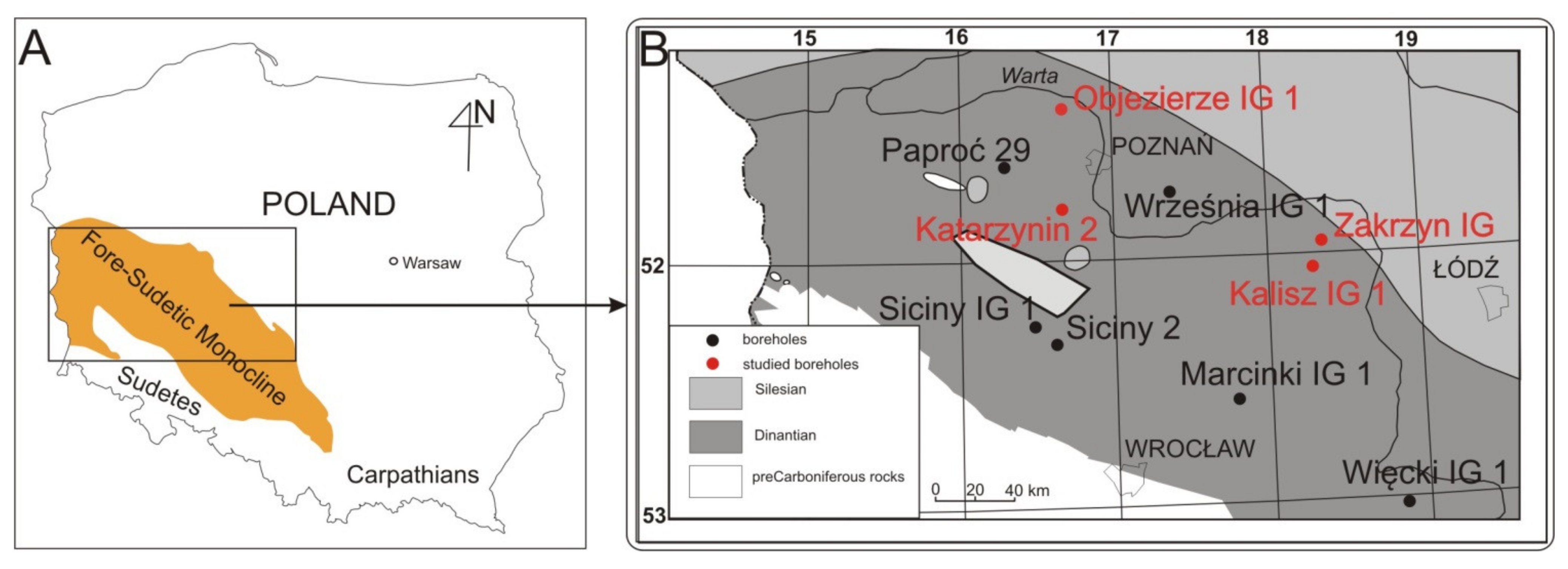
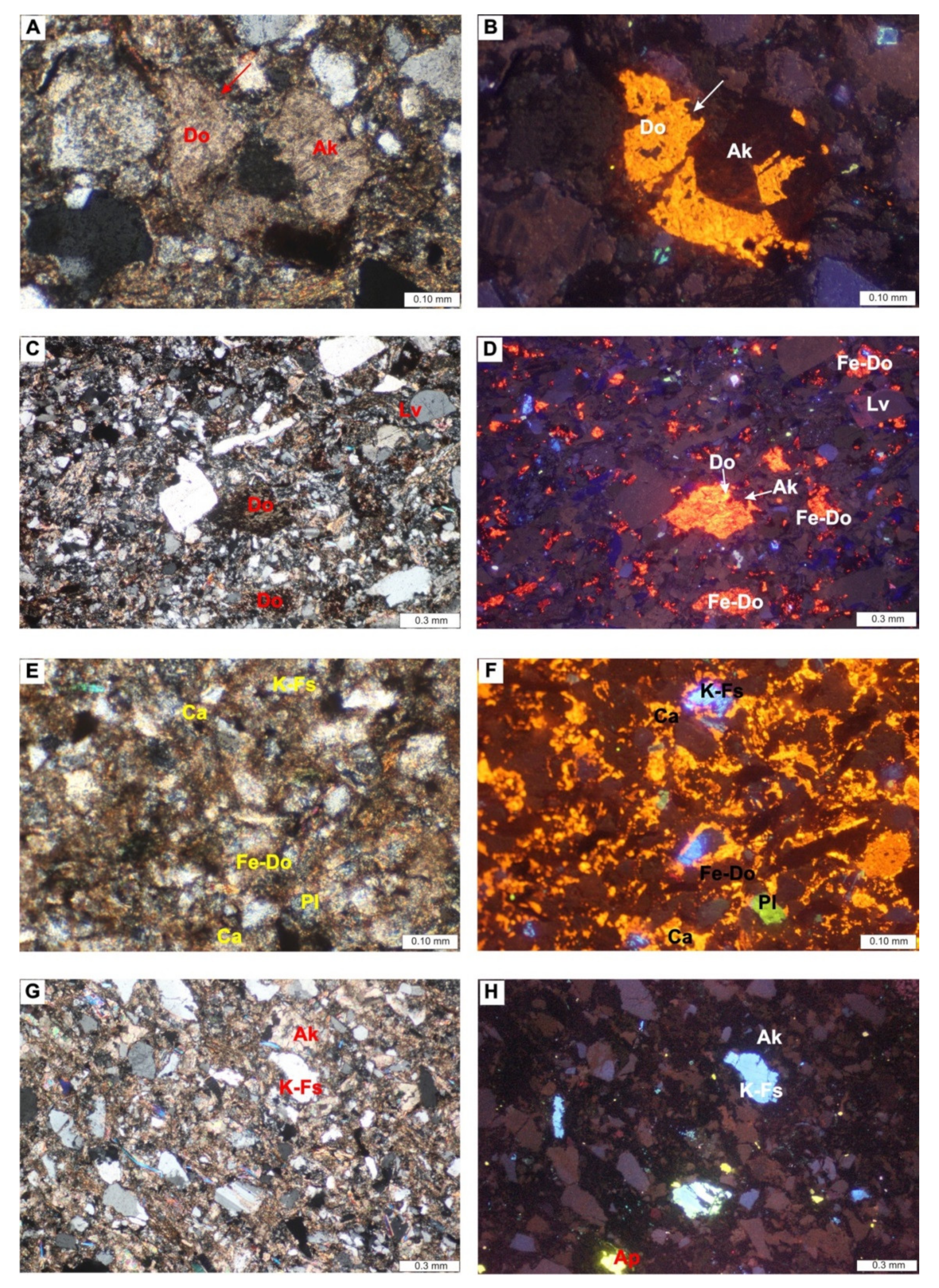
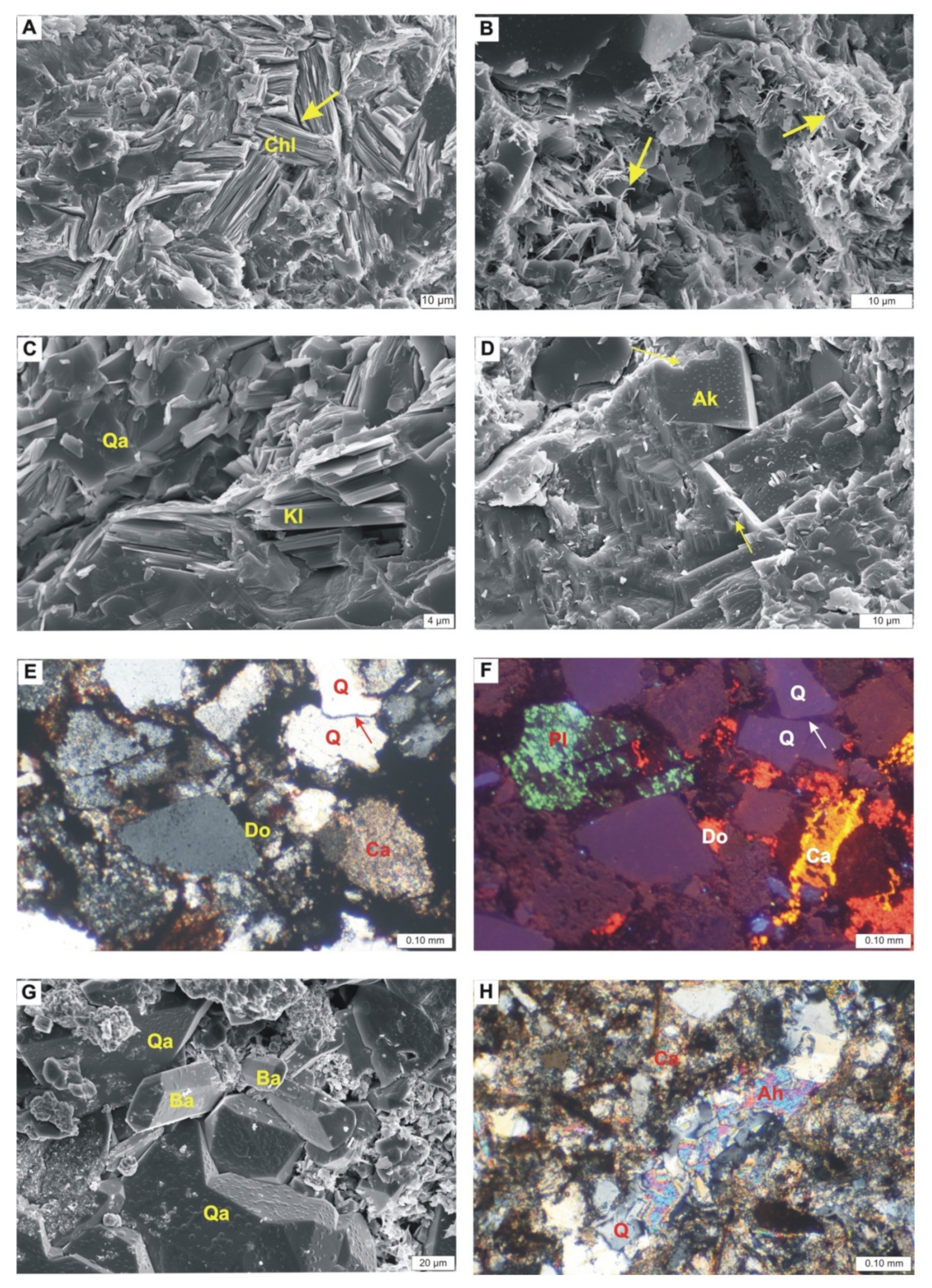
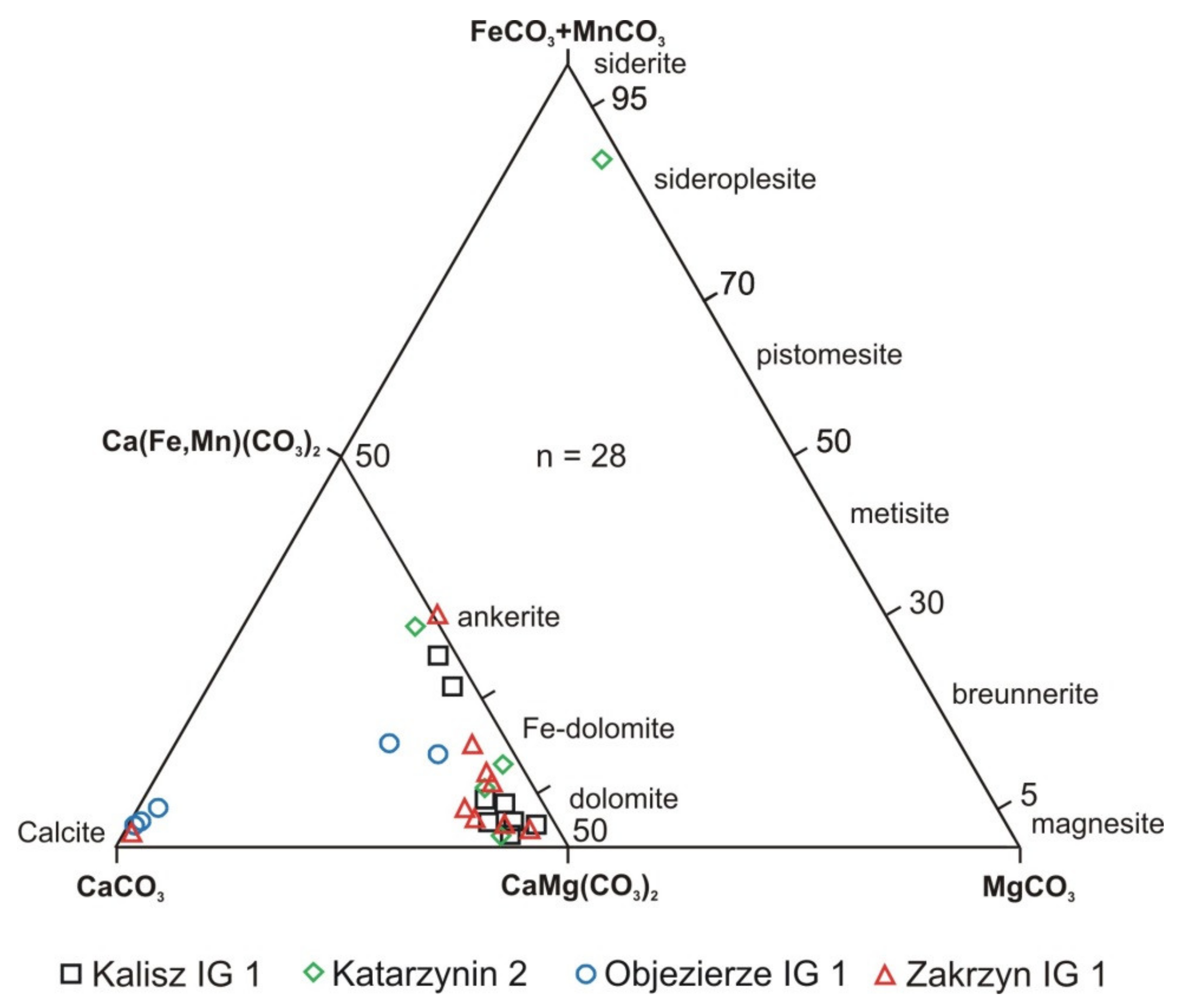
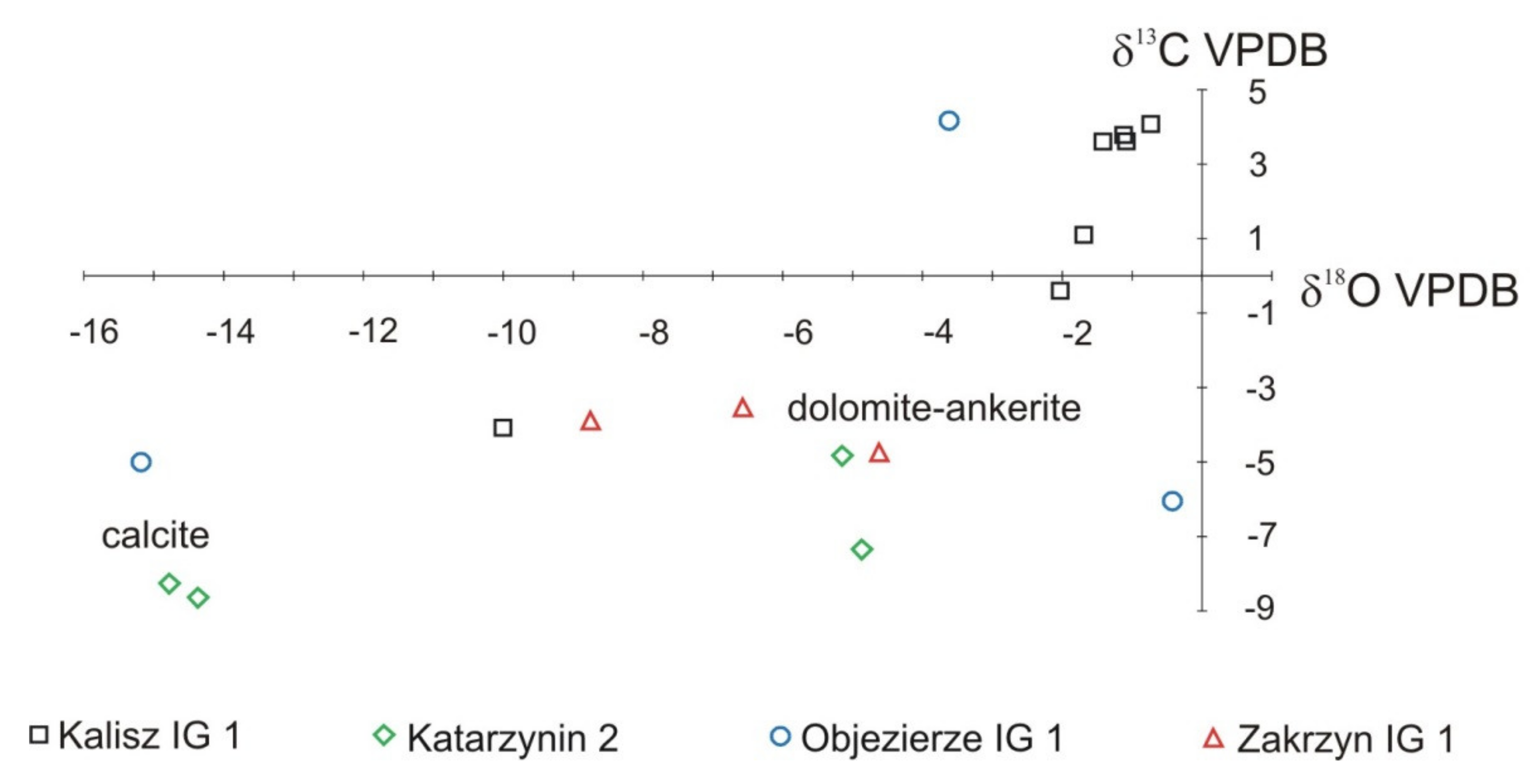
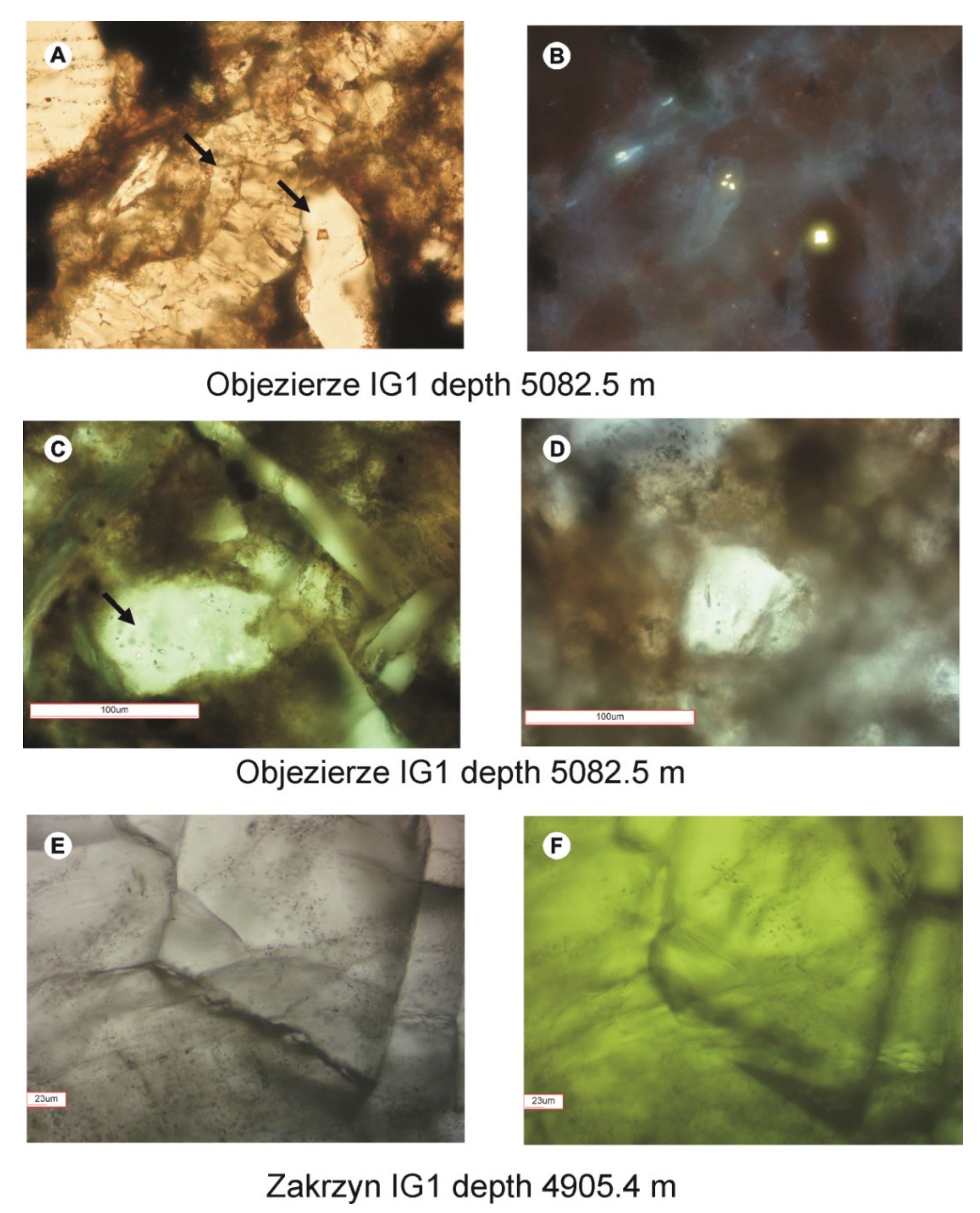


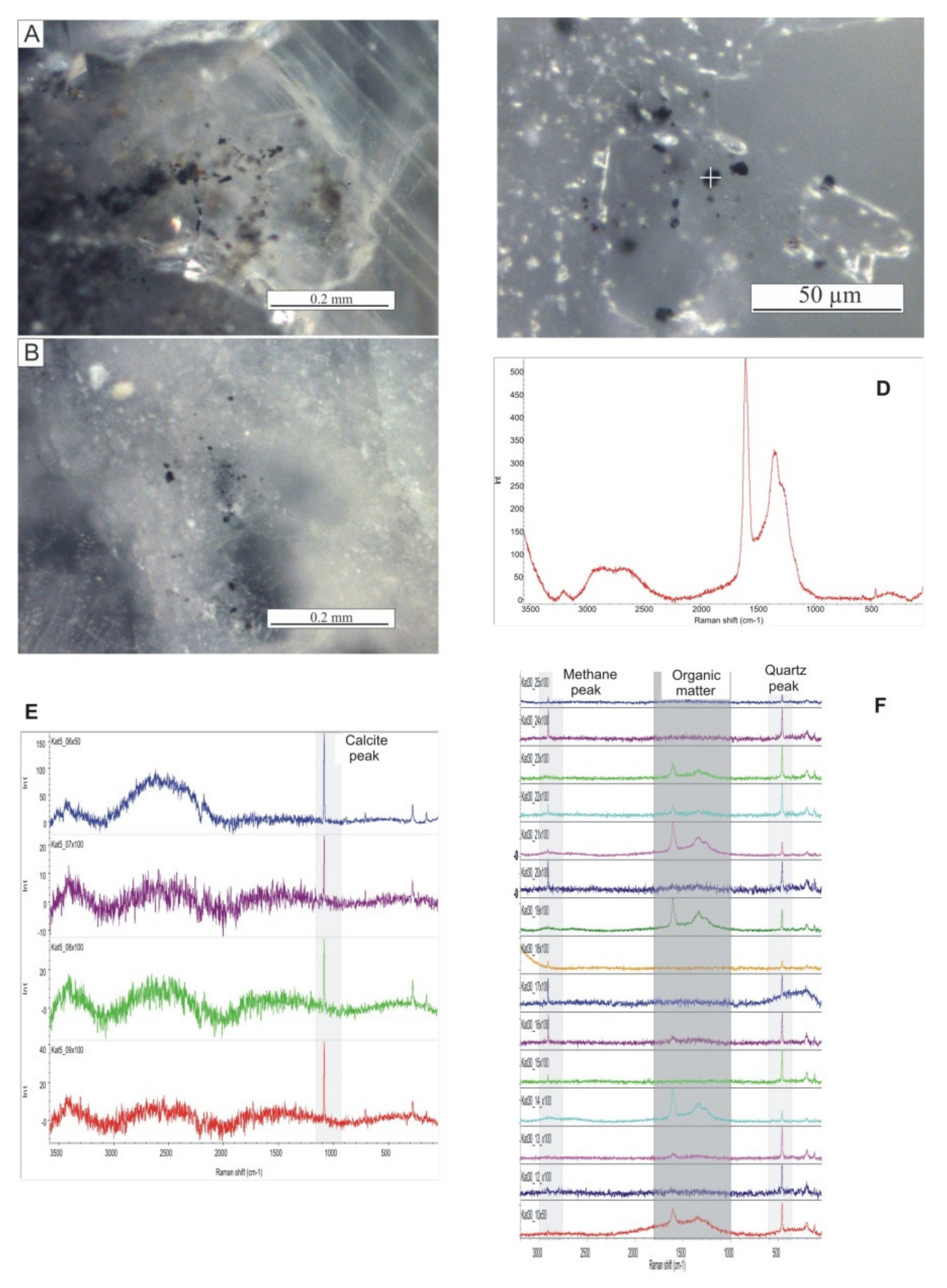
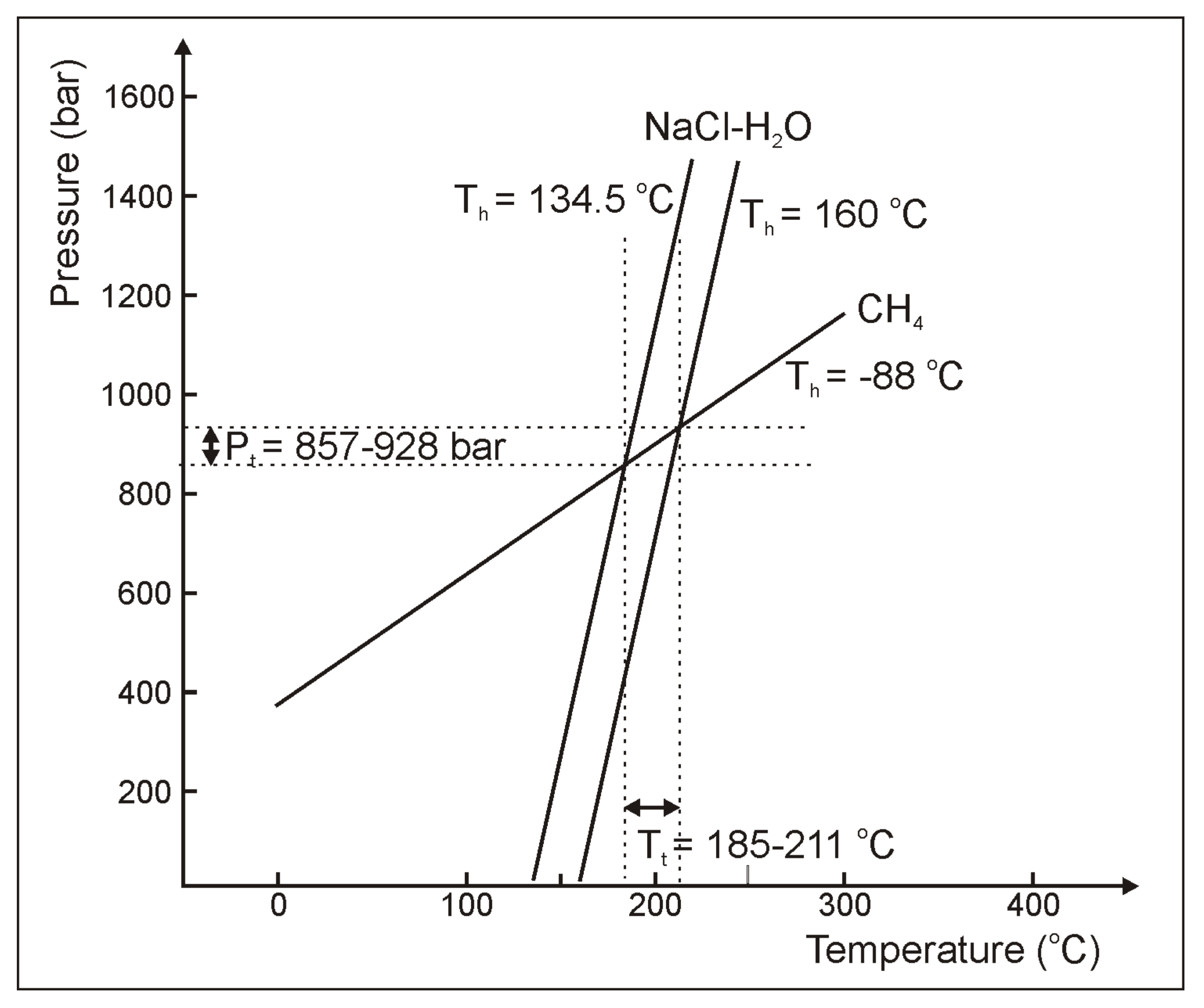

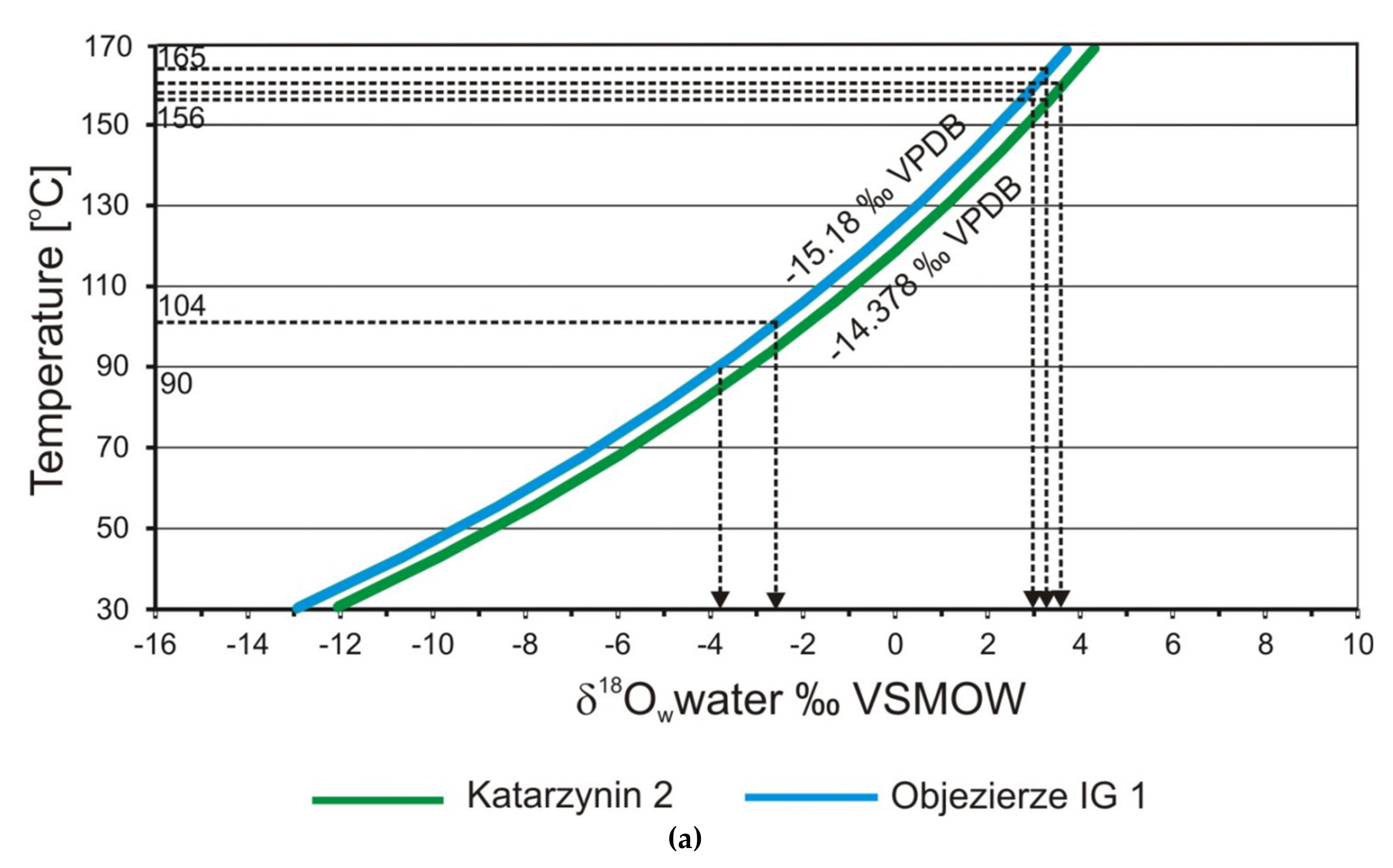

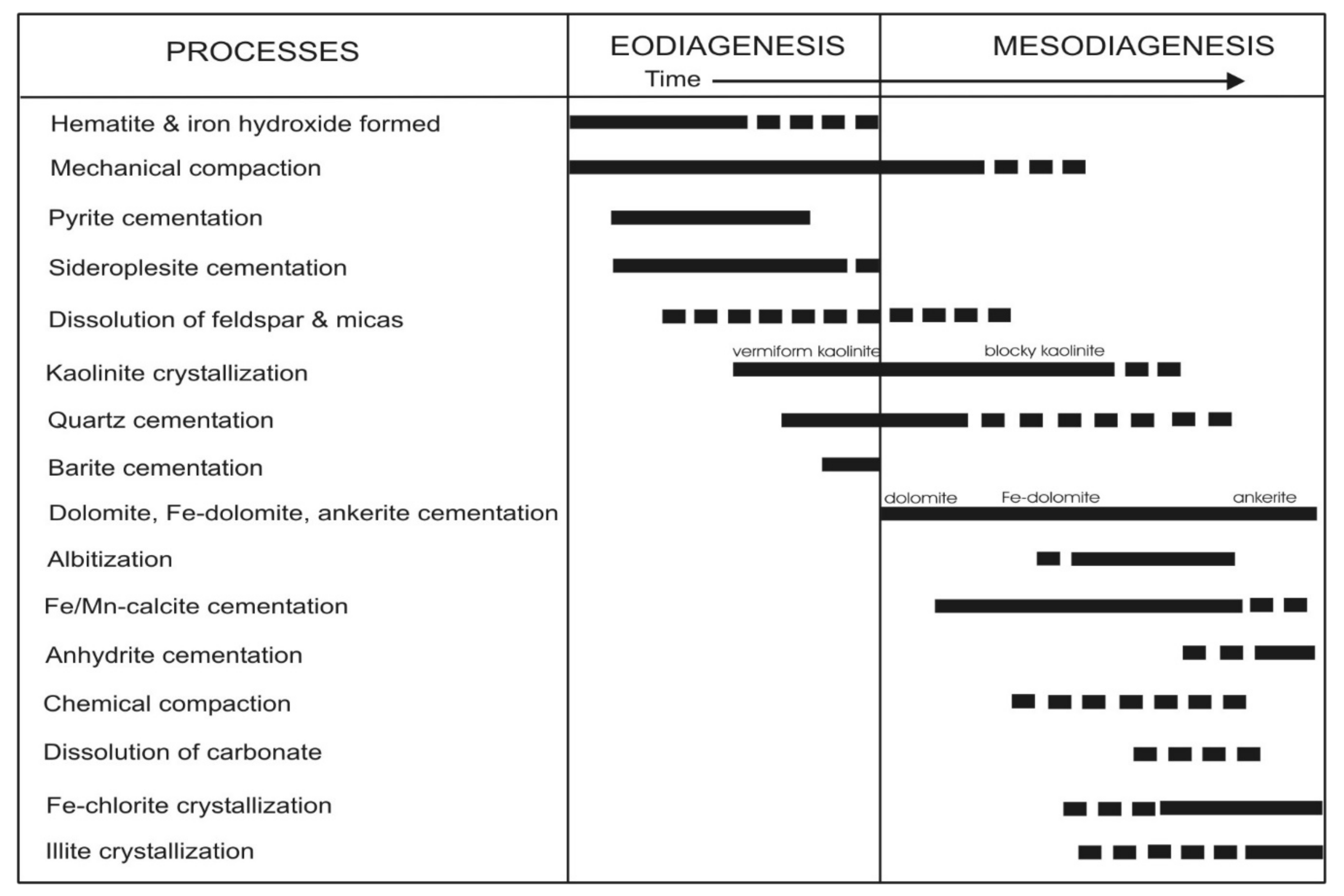
| Borehole | Depth (m) | Rock Type | Analytical Point | SiO2 | Al2O3 | K2O | Na2O | CaO | FeO | TiO2 | MnO | Feldspar Type |
|---|---|---|---|---|---|---|---|---|---|---|---|---|
| Katarzynin 2 | 2588.1 | sublithic | 1 | 63.98 | 22.00 | 0.33 | 9.35 | 2.68 | 0.08 | 0.08 | 0.02 | Albite |
| wacke | 2 | 65.46 | 18.95 | 14.41 | 1.54 | 0.00 | 0.05 | 0.08 | 0.00 | K-feldspar | ||
| 3 | 64.48 | 21.74 | 0.54 | 10.22 | 0.76 | 0.20 | 0.01 | 0.09 | Albite | |||
| 2591.8 | sublithic wacke | 1 | 68.10 | 20.87 | 0.43 | 10.87 | 0.43 | 0.59 | 0.03 | 0.06 | Albite | |
| Objezierze IG 1 | 5083.9 | subarkosic | 1 | 66.66 | 21.56 | 0.24 | 9.10 | 2.26 | 0.00 | 0.03 | 0.00 | Albite |
| wacke | 2 | 69.18 | 19.68 | 0.06 | 10.62 | 0.36 | 0.00 | 0.00 | 0.00 | Albite | ||
| 3 | 68.27 | 20.50 | 0.56 | 10.58 | 0.47 | 0.00 | 0.00 | 0.00 | Albite | |||
| 5085.7 | subarkosic wacke | 1 | 63.49 | 18.89 | 16.22 | 0.43 | 0.00 | 0.00 | 0.12 | 0.13 | K-feldspar | |
| 5090.0 | subarkosic | 1 | 65.35 | 18.43 | 16.02 | 0.99 | 0.01 | 0.00 | 0.00 | 0.00 | K-feldspar | |
| arenite | 2 | 69.55 | 19.49 | 0.00 | 12.14 | 0.00 | 0.08 | 0.00 | 0.00 | Albite | ||
| 3 | 65.39 | 18.42 | 16.57 | 0.46 | 0.12 | 0.00 | 0.00 | 0.00 | K-feldspar | |||
| Zakrzyn IG 1 | 4599.1 | sublithic | 1 | 66.86 | 21.49 | 0.12 | 9.87 | 1.44 | 0.17 | 0.00 | 0.16 | Albite |
| wacke | 2 | 68.42 | 20.66 | 0.42 | 10.41 | 0.14 | 0.11 | 0.00 | 0.10 | Albite | ||
| 3 | 68.54 | 19.92 | 0.08 | 12.35 | 0.00 | 0.20 | 0.00 | 0.10 | Albite | |||
| 4 | 67.89 | 18.63 | 0.17 | 12.03 | 0.20 | 0.04 | 0.00 | 0.04 | Albite | |||
| 5 | 67.90 | 19.12 | 0.02 | 12.11 | 0.04 | 0.00 | 0.00 | 0.00 | Albite | |||
| 4721.7 | sublithic | 1 | 69.41 | 19.09 | 0.21 | 10.34 | 0.04 | 0.95 | 0.09 | 0.12 | Albite | |
| wacke | 2 | 67.44 | 20.94 | 0.05 | 10.70 | 1.40 | 0.01 | 0.01 | 0.09 | Albite |
| Borehole | Depth (m) | Rock Type | Analytical Point | Mg wt% | Ca wt% | Mn wt% | Fe wt% | MgCO3 mole% | CaCO3 mole% | MnCO3 mole% | FeCO3 mole% | Carbonate Type |
|---|---|---|---|---|---|---|---|---|---|---|---|---|
| Kalisz IG 1 | 3570.1 | subarkosic | 1 | 11.80 | 22.28 | 0.94 | 1.80 | 40.2 | 54.2 | 1.9 | 3.6 | Dolomite |
| arenite | 2 | 13.51 | 21.86 | 1.25 | 0.13 | 45.1 | 52.1 | 2.5 | 0.3 | Dolomite | ||
| 3 | 12.53 | 22.54 | 1.29 | 0.30 | 42.4 | 54.4 | 2.6 | 0.6 | Dolomite | |||
| 4 | 12.59 | 22.84 | 0.57 | 0.15 | 42.9 | 55.6 | 1.2 | 0.3 | Dolomite | |||
| 5 | 6.55 | 20.57 | 0.64 | 10.96 | 23.3 | 52.3 | 1.4 | 23.1 | Ankerite | |||
| 3598.0 | muddy | 1 | 10.87 | 22.87 | 0.88 | 2.04 | 37.8 | 56.2 | 1.8 | 4.2 | Fe-dolomite | |
| claystone | 2 | 7.78 | 21.15 | 1.01 | 8.95 | 27.0 | 52.5 | 2.1 | 18.4 | Ankerite | ||
| 3 | 11.31 | 22.84 | 1.10 | 0.39 | 39.7 | 57.2 | 2.3 | 0.8 | Dolomite | |||
| Katarzynin 2 | 2374.1 | lithic | 1 | 12.19 | 23.17 | 0.58 | 0.04 | 41.9 | 56.8 | 1.2 | 0.1 | Dolomite |
| wacke | 2 | 2.72 | 0.85 | 0.33 | 41.38 | 9.7 | 2.2 | 0.7 | 87.4 | sideroplesite | ||
| 3 | 5.54 | 21.49 | 1.04 | 12.77 | 19.0 | 52.8 | 2.2 | 26.0 | Ankerite | |||
| 4 | 10.99 | 21.36 | 1.05 | 4.12 | 37.5 | 52.0 | 2.2 | 8.3 | Fe-dolomite | |||
| 5 | 10.68 | 22.43 | 1.78 | 1.89 | 37.0 | 55.5 | 3.7 | 3.8 | Fe-dolomite | |||
| Objezierze IG 1 | 5085.7 | subarkosic wacke | 2 | 0.20 | 36.96 | 0.84 | 0.40 | 0.7 | 96.6 | 1.8 | 0.9 | Mn/Fe-calcite |
| 5090.0 | subarkosic | 1 | 0.30 | 38.22 | 0.94 | 0.57 | 1.1 | 95.8 | 2.0 | 1.2 | Mn/Fe-calcite | |
| arenite | 2 | 0.64 | 37.91 | 1.27 | 1.12 | 2.2 | 92.9 | 2.6 | 2.3 | Mn/Fe-calcite | ||
| 3 | 8.51 | 23.49 | 3.11 | 2.56 | 29.7 | 58.5 | 6.5 | 5.3 | Fe-dolomite | |||
| 4 | 0.21 | 38.33 | 1.19 | 0.10 | 0.7 | 96.5 | 2.5 | 0.2 | Mn-calcite | |||
| 5 | 6.74 | 25.23 | 2.67 | 3.68 | 23.6 | 63.2 | 5.6 | 7.6 | Fe-dolomite | |||
| Zakrzyn IG 1 | 4560.2 | sublithic | 1 | 10.52 | 21.93 | 0.70 | 3.96 | 36.3 | 54.1 | 1.4 | 8.1 | Fe-dolomite |
| arenite | 2 | 12.71 | 21.20 | 0.66 | 0.36 | 44.7 | 53.2 | 1.4 | 0.8 | Dolomite | ||
| 3 | 12.53 | 22.08 | 0.96 | 0.44 | 43.0 | 54.1 | 2.0 | 0.9 | Dolomite | |||
| 4 | 9.42 | 21.60 | 0.81 | 5.52 | 32.9 | 54.0 | 1.7 | 11.4 | Fe-dolomite | |||
| 4564.3 | sublithic | 1 | 0.22 | 38.62 | 0.37 | 0.50 | 0.8 | 97.4 | 0.8 | 1.0 | Fe/Mn-calcite | |
| wacke | 2 | 10.10 | 23.07 | 1.29 | 2.83 | 36.2 | 59.0 | 2.8 | 2.1 | Dolomite | ||
| 3 | 11.02 | 23.76 | 1.13 | 0.64 | 37.9 | 58.4 | 2.3 | 1.3 | Dolomite | |||
| 4705.4 | sublithic | 1 | 10.82 | 21.98 | 1.26 | 2.76 | 37.5 | 54.3 | 2.6 | 5.6 | Fe-dolomite | |
| wacke | 2 | 6.06 | 19.83 | 0.94 | 13.62 | 21.0 | 49.1 | 2.0 | 27.9 | Ankerite |
| Borehole | Depth (m) | Type of Carbonate Mineral | Delta 13 C ‰ VPDB | Delta 18 O ‰ VPDB |
|---|---|---|---|---|
| Kalisz IG 1 | 3368.80 | Dolomite-Ankerite | 4.07 | −0.74 |
| Kalisz IG 1 | 3369.80 | Dolomite-Ankerite | 3.59 | −1.44 |
| Kalisz IG 1 | 3379.10 | Dolomite-Ankerite | 3.75 3.61 | −1.14 −1.08 |
| Kalisz IG 1 | 3461.00 | Dolomite-Ankerite | 1.08 | −1.70 |
| Kalisz IG 1 | 3475.20 | Fe-dolomite/Ankerite | −0.39 | −2.03 |
| Kalisz IG 1 | 3589.30 | Dolomite-Ankerite | −4.05 | −10.01 |
| Katarzynin 2 | 2374.10 | Dolomite-Ankerite | −4.84 | −5.15 |
| Katarzynin 2 | 2432.30 | Calcite | −8.68 | −14.378 |
| Katarzynin 2 | 2588.45 | Calcite | −8.28 | −14.78 |
| Katarzynin 2 | 2638.60 | Dolomite-Ankerite | −7.35 | −4.87 |
| Objezierze IG 1 | 4895.70 | Dolomite-Ankerite | −6.07 | −0.42 |
| Objezierze IG 1 | 4900.20 | Dolomite-Ankerite | 4.19 | −3.62 |
| Objezierze IG 1 | 5082.50 | Calcite | −5.00 | −15.18 |
| Objezierze IG 1 | 5082.50 | Calcite | −4.96 | −15.17 |
| Zakrzyn IG 1 | 4705.40 | Dolomite-Ankerite | −4.78 | −4.63 |
| Zakrzyn IG 1 | 4872.20 | Fe-dolomite/Ankerite | −3.90 | −8.74 |
| Zakrzyn IG 1 | 4905.40 | Ankerite | −3.58 | −6.57 |
| Sample | Microthermometry(°C) | Salinity Weight % NaCl eq.) | Fluid Density (g/cm3) | Type of Fluid | Remarks | ||
|---|---|---|---|---|---|---|---|
| Objezierze IG 1 Depth 4895.7 m | Th | Te | Tm | ||||
| AQFI Quartz Dolomite-ankerite | 228 200 120 90 104 | −36.0 −32.0 | −7.5 −3.0 −2.4 −9.2 | 11.10 4.86 3.96 13.078 | 0.926 0.906 0.972 0.972 | Brine | Figure 6C,D Figure 6A,B |
| Objezierze IG 1 Depth 5082.5 m | |||||||
| AQFI Calcite Quartz | 165 158 90 104 120 | −44.3 −44.3 −36.0 −42.0 | −9.9 −9.9 −9.2 −2.4 | 13.839 13.078 3.916 | 1.005 1.058 0.972 | Brine | |
| Zakrzyn IG 1 Depth 4905. 4 m | |||||||
| AQFI Ankerite | 76.9 134.5 115 160 | −36 −44 −44 | −5.0 −2.8 −2.8 −8.1 | 7.82 4.55 11.82 | 1.027 0.965 0.965 | Brine | Primary FI Secondary FI |
| HCFI | −88 | CH4 | |||||
| Microthermometry | |||||
|---|---|---|---|---|---|
| Sample/ Inclusion Size | Depth/ FI Character | Th (°C) | Te (°C) | Tm/Tc (°C) | Remarks |
| Katarzynin 2 | Depth 2432.3 m | Figure 7A,B; Raman analysis | |||
| Katarzynin 2 calcite | Depth 2510.6 m | ||||
| 5 µm | Monophase rhombohedral elongated | −92.6 | |||
| 3–6 µm | Two-phase rounded | 156–163 | −21 | −2.6 to −0.1 | |
| Katarzynin 2 calcite | Depth 2588.45 m | Figure 7C,D | |||
| 2 µm | Monophase elongated | −96.6 +23.2 | |||
| 2–3 µm | Two-phase angular | 233 | −44.3 to −38.0 | −9.9 to −6.5/+2.2 | |
| Katarzynin 2 Fe-dolomite/ankerite | Depth 2638.6 m | Figure 7E,F; Raman analysis | |||
| 2–5 µm | Monophase elongated Oval | −101 | |||
| 2 µm | Two-phase irregular | 113 | −33.0 | −5.8/+1.5 | |
| Microthermometry | |||||||
|---|---|---|---|---|---|---|---|
| Borehole Depth | Mineral | Th (°C) | Te (°C) | Tm/Tc (°C) | Fluid Salinity (wt. % NaCl eq.) | Fluid Density (g/cm3) | Remarks |
| Katarzynin 2 2510.6 m | calcite | −92.6 156–163 | −21 | −2.6 | 4.232 | 0.274 0.938 | CH4 Brine I |
| Katarzynin 2 2588. 45 m | calcite | −96.6 233 | +23.2 −44.3 to –38 | −9.9 to −6.5/+2.2 | 13.839– 9.844 | 0.290 0.942–0.911 | CH4 CO2 Brine II |
| Katarzynin 2 2638.6 m | Fe-dolomite/ ankerite | −101 113 | −5.8 | 8.92 | 0.304 1.011 | CH4 Brine III | |
| Zakrzyn IG 1 4905.4 m | Ankerite | 134.4 | −44 | −2.8 | 4.6 | 0.965 | Brine |
| −88 | 0.251 | CH4 | |||||
| Sample no. and Statistic Parameters | FWHM D4 (cm−1) | FWHM D1 (cm−1) | FWHM D3 (cm−1) | FWHM G (cm−1) | Temperature 1 (°C) | Temperature 2 (°C) |
|---|---|---|---|---|---|---|
| Katarzynin 2 Depth 2432.3 m | ||||||
| Kat5_01 × 50 | 143.67 | 143.05 | 143.05 | 56.96 | 170.44 | 148.81 |
| Kat5_02 × 50 | 139.42 | 151.82 | 151.82 | 56.36 | 151.58 | 152.87 |
| Kat5_03 × 50 | 139.06 | 152.93 | 152.93 | 55.92 | 149.19 | 155.83 |
| Kat5_04 × 50 | 148.42 | 140.94 | 140.94 | 57.1 | 174.98 | 147.86 |
| Kat5_05 × 50 | 158.51 | 137.9 | 137.9 | 53.08 | 181.52 | 175.11 |
| Mean | 146.35 | 145.9 | 145.9 | 55.62 | 164.32 | 157.92 |
| Mediana | 143.92 | 146.38 | 146.38 | 56.14 | 163.28 | 154.35 |
| SD | 9.19 | 7.6 | 7.6 | 1.76 | 16.34 | 11.93 |
| CV [%] | 6.28 | 5.21 | 5.21 | 3.16 | 9.94 | 7.55 |
| Katarzynin 2 Depth 2638.6 m | ||||||
| Kat30_01 × 50 | 119.54 | 141.08 | 190.88 | 50.27 | 174.67 | 194.18 |
| Kat30_02 × 50 | 117.44 | 134 | 185.27 | 49.37 | 189.89 | 200.3 |
| Kat30_03 × 50 | 117.6 | 135.11 | 184.8 | 48.79 | 187.51 | 204.17 |
| Kat30_04 × 50 | 106.54 | 142.41 | 174.16 | 49.32 | 171.83 | 200.59 |
| Kat30_05 × 50 | 114.07 | 135.77 | 255 | 49.45 | 186.09 | 199.73 |
| Kat30_06 × 50 | 198.21 | 159.46 | 185.13 | 57.02 | 135.16 | 148.43 |
| Kat30_06 × 50a | 195.36 | 167.65 | 162.9 | 56.98 | 117.55 | 148.65 |
| Kat30_07 × 50 | 113.2 | 131.41 | 303.44 | 49.27 | 195.46 | 200.96 |
| Kat30_09 × 50 | 145.93 | 119.13 | 313.74 | 52.59 | 221.87 | 178.42 |
| Kat30_10 × 50 | 129.31 | 123.04 | 304.38 | 43.26 | 213.46 | 241.69 |
| Kat30_14 × 100 | 80.5 | 116.7 | 262.68 | 32.82 | 227.09 | 312.47 |
| Kat30_19 × 100 | 108.31 | 101.87 | 237.03 | 29.5 | 258.97 | 335 |
| Kat30_21 × 100 | 72.25 | 127.34 | 283.23 | 33.46 | 204.22 | 308.14 |
| Kat30_23 × 100 | 107.7 | 93.98 | 232.71 | 35.12 | 275.93 | 296.91 |
| Mean | 12328 | 130.64 | 233.95 | 45.52 | 197.12 | 226.4 |
| Mediana | 115.75 | 132.71 | 234.87 | 49.3 | 192.68 | 200.77 |
| SD | 35.96 | 19.75 | 53.72 | 9.12 | 42.47 | 61.86 |
| CV [%] | 29.17 | 15.12 | 22.96 | 20.05 | 21.55 | 27.33 |
| Sample/Depth (m) | Chemical System | |||||
|---|---|---|---|---|---|---|
| Zakrzyn IG 1/4905.4 m | H2O– Primary | NaCl inclusions | CH4 | |||
| Eqn of state | Brown and Lamb * | Brown and Lamb | Holloway | |||
| Freezing point depression (°C) | −2.8 | −8.1 | ||||
| NaCl molality | 0.815 | 2.294 | ||||
| Mole fraction NaCl | 0.014 | 0.040 | ||||
| Weight per cent NaCl | 4.55 | 11.821 | ||||
| Vapor out temp. (°C)/ Homogenization (°C) | 134.5 | 160 | −88 | |||
| Bulk molar volume | 19.27 | 19.73 | ||||
| Critical point | 416.1 | 482.3 | ||||
| Density (g/cm3) | 0.965 | 0.994 | 0.251 | |||
| Isochore | Temperature (°C) pressure (bars) | Temperature (°C) pressure (bars) | Temperature (°C) pressure (bars) | |||
| 150 200 250 300 | 280 1168 2056 2945 | 200 250 300 | 710 1591 2472 | 150 200 250 300 | 766 902 1035 1166 | |
| Katarzynin 2/2510.6 m | H2O– Primary inclusion | NaCl Secondary inclusion | CH4 | |||
| Eqn of state | Brown and Lamb | Brown and Lamb | Holloway | |||
| Freezing point depression (°C) | −2.6 | −2.6 | ||||
| NaCl molality | 0.815 | 0.756 | ||||
| Mole fraction NaCl | 0.014 | 0.013 | ||||
| Weight per cent NaCl | 4.23 | 4.32 | ||||
| Vapor out temp. (°C)/ Homogenization (°C) | 156 | 163 | −92.6 | |||
| Bulk molar volume | 19.05 | 19.79 | ||||
| Critical point | 416.1 | 413.1 | ||||
| Density (g/cm3) | 0.974 | 0.938 | 0.274 | |||
| Isochore | Temperature (°C) pressure (bars) | Temperature (°C) pressure (bars) | Temperature (°C) pressure (bars) | |||
| 200 250 300 | 774 1648 2389 | 200 250 300 | 649 1619 2389 | 200 250 300 | 1078 1236 1392 | |
Publisher’s Note: MDPI stays neutral with regard to jurisdictional claims in published maps and institutional affiliations. |
© 2021 by the authors. Licensee MDPI, Basel, Switzerland. This article is an open access article distributed under the terms and conditions of the Creative Commons Attribution (CC BY) license (https://creativecommons.org/licenses/by/4.0/).
Share and Cite
Kozłowska, A.; Jarmołowicz-Szulc, K.; Kuberska, M.; Wołkowicz, K. Formation of Diagenetic Minerals in the Carboniferous Rock Complex from the Fore-Sudetic Monocline (SW Poland): Fluid Inclusion, Isotopic and Raman Constraints. Minerals 2021, 11, 976. https://doi.org/10.3390/min11090976
Kozłowska A, Jarmołowicz-Szulc K, Kuberska M, Wołkowicz K. Formation of Diagenetic Minerals in the Carboniferous Rock Complex from the Fore-Sudetic Monocline (SW Poland): Fluid Inclusion, Isotopic and Raman Constraints. Minerals. 2021; 11(9):976. https://doi.org/10.3390/min11090976
Chicago/Turabian StyleKozłowska, Aleksandra, Katarzyna Jarmołowicz-Szulc, Marta Kuberska, and Krystyna Wołkowicz. 2021. "Formation of Diagenetic Minerals in the Carboniferous Rock Complex from the Fore-Sudetic Monocline (SW Poland): Fluid Inclusion, Isotopic and Raman Constraints" Minerals 11, no. 9: 976. https://doi.org/10.3390/min11090976
APA StyleKozłowska, A., Jarmołowicz-Szulc, K., Kuberska, M., & Wołkowicz, K. (2021). Formation of Diagenetic Minerals in the Carboniferous Rock Complex from the Fore-Sudetic Monocline (SW Poland): Fluid Inclusion, Isotopic and Raman Constraints. Minerals, 11(9), 976. https://doi.org/10.3390/min11090976







